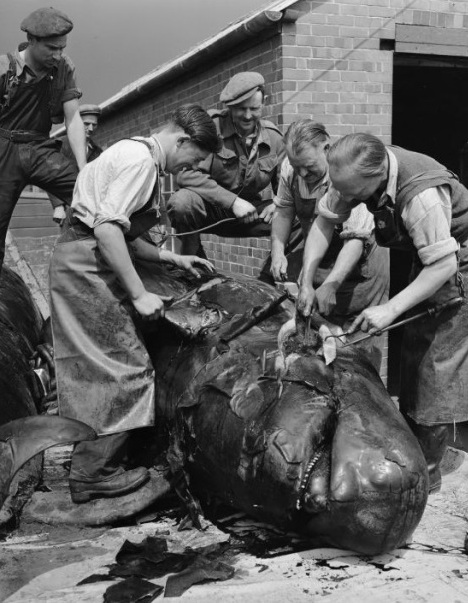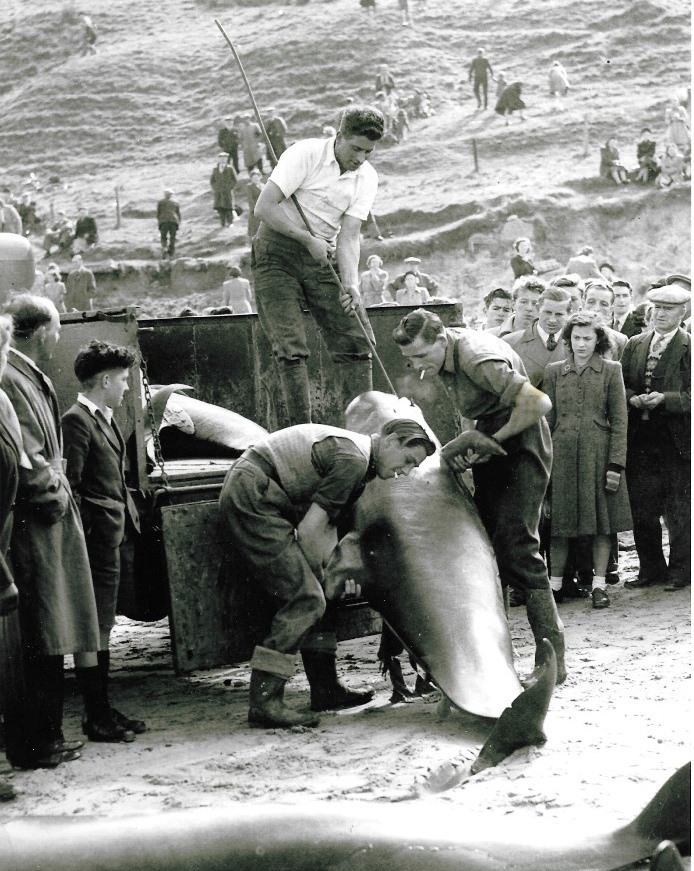This month, we are returning to 1950 and the stranding of 147 pilot whales at Thorntonloch. Jim Herring had a request for his 2016 book Stranded: The Whales at Thorntonloch from a man in Shropshire who had been researching his local area around Ellesmere. He came across photos from a slaughterhouse in Hordley. The photos – some of which are discussed below – are from a National Library of Wales site – link here. The website notes “Images of deceased whales on the back of a truck; they had become stranded off Scottish coast and were sold to the horse and cattle slaughterers T C Price at Hordley. The whales yielded oil, high grade fertiliser and fishmeal”. An extract from a local newspaper indicated that 41 of the 147 whales stranded at Thorntonloch had been transported to the Shropshire slaughterhouse. On page 16 of the whales’ book, the author writes that the Haddingtonshire Courier had reported that the whales went to many parts of Britain, including “Ellesmere in Shropshire”. The hamlet of Hordley is 300 miles from Dunbar and the speed limit for lorries in 1950 was 20mph, so it would have taken a long time for the whales to be transported. The photos are shown here under the Creative Commons Licence. ** A warning. Some people might regard the photos as gruesome!
The first photo above shows the two whales which are almost the length of the lorry and the staff of the slaughterhouse. The photos are obviously staged for the camera, with the slaughterhouse men on the lorry and presumably the three managers/office staff in front. What can also be seen from this photo is, as at Thorntonloch when the whales were loaded on to the lorries, there is a distinct lack of health and safety precautions i.e. this photo could not be taken today. The date on the photos on the website is 30 May 1950. The whales stranded on the 13th May and the last were carted away from the beach on Monday 15th May. This means that the whales had been dead for more than a fortnight. Given that people complained of the smell of the whales on the beach on Monday 15th May, the stench from them by 30th must have been awful, unless there was some method of sanitizing them – unlikely.
If you enlarge this photo, you will see that the men are using a very long and fairly wide-bladed tool and this is held in place by another man holding a rope. These men normally slaughtered and cut up cattle for butchers, so they would be using their normal equipment, which was different from the tools used to cut up whales. After contact with the New Bedford Whaling Museum about the tools in the photo above, the reply was “In closely examining your photos I see nothing to indicate that these men are processing those pilot whales in any traditional whaling fashion. I see no flensing knives, no windlass or capstan, no blubber hooks, pikes or gaffs. In fact, I see no tools whatever, apart from one hand hook and a butcher knife in one of the photos”. Flensing knives (photo) came with different shaped heads and were used to remove the blubber. Scran can tell you more about flensing. For other tools mentioned above, see here. So this would be a new experience for these slaughterhouse men? Would it have been an interesting one?
The final photo above from the collection is perhaps the most interesting – or gruesome? The men appear to be very aware of the camera and are perhaps joking about something. They also appear to be having difficulty removing the outer layer of the whale’s skin – perhaps their tools were insufficient to make this a straightforward process. One of the men is using a hook as well as a knife, while the other man’s knife looks far too small to be effective on this huge sea creature. While this may appear a grisly sight to us, the slaughterhouse men would probably have taken it in their stride – another task, another challenge. In a social sense, the whales would no doubt have been the subject of stories told to families or pals in the pub.
The photo above from the whales’ book also shows the lack of health and safety at the time. One noticeable aspect of this photo is that the men lifting the whale on to the lorry are smoking untipped cigarettes. The photos from Hordley look sanitised – for the camera – and only in the second photo can you see a man – sitting at the rear side of the lorry – who is smoking. It’s unlikely that, if photos had been taken without the workers’ knowledge, at least some of them would have been smoking, given that in 1950, 85% of men admitted that they smoked. The boy in the photo above to the left of the lorry is Sandy Darling who cycled from Stenton to see the whales. An interview with Sandy Darling appeared in The Guardian newspaper’s That’s me in the picture feature and you can read it here.




You must be logged in to post a comment.